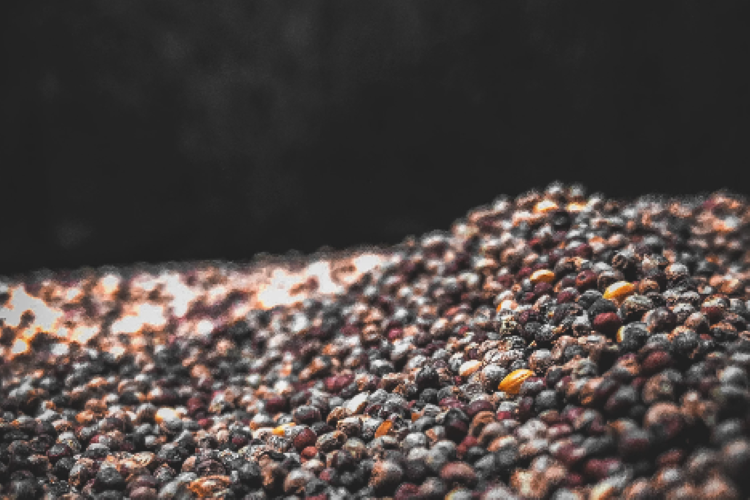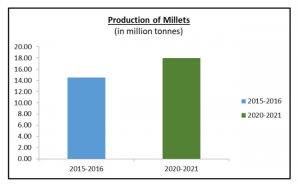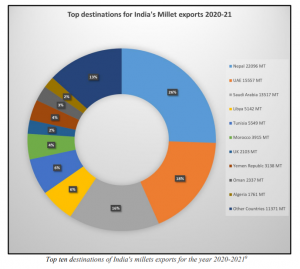
The Russia-Ukraine war has brought to the fore the heavy reliance of several countries on imported wheat. Russia is the world’s largest wheat exporter while Ukraine is the fifth, and together they account for a fifth of the wheat supply. The war has triggered an unprecedented food crisis, leading the world to look beyond wheat and rice.
India stands at a unique point in history to usher in a worldwide millet revolution. Millets have the potential to address the greatest challenges of the 21st century, including achieving nutritional security as well as helping in the fight against climate change while also promoting sustainable agriculture.
The UN General Assembly has adopted a resolution declaring 2023 as the International Year of Millets. The proposal was put forward by India and was endorsed by the members of FAO governing bodies at the 75th session of the General Assembly. Millets were traditional staple for crores of people in Sub-Saharan Africa and Asia for 7000 years. However, the cultivation has declined in these areas.


Millets are nutrient-dense, low-input intensive crops. Over 10 million tonnes of millets are produced in India, and they contribute around 1% to the country’s food basket. The United Nations Food and Agricultural Programme has recognised the importance of millets for meeting Sustainable Development Goals 2, 3, 12, and 13. India had declared 2018 the national year of millets.
There has been a decline in the consumption and cultivation of millets due to various reasons. With globalisation, there has been a drastic change in dietary habits and these ancient grains were considered poor man’s food or inferior food items and were eventually replaced by carbohydrate-dominated grains such as rice and wheat.
Rice and wheat grained popularity and preparation of millet-based foods were considered an inconvenience. This, in turn, led to nutritional insecurity and related health ailments. In addition, the popularity of rice and wheat lead to unsustainable agricultural practices and poor income levels in rainfed areas. The extensive use of fertilizers ruined soil health and water quality in the several states in Punjab, West Bengal, Tamil Nadu, and Andhra Pradesh.
READ I Odisha Millets Mission extends lessons for other states, nations
Millets gaining popularity
Vegan diets and gluten-free meals started gaining popularity, bringing about a renewed interest in millets. Their high nutritional value has made them a popular food choice among health-conscious people. Millets are five times more nutritious than rice and wheat in terms of proteins, minerals and vitamins.
They are a rich source of calcium, iron, vitamin B, magnesium, potassium and zinc. It is also gluten-free and has a low glycaemic index, thereby helps in reducing cholesterol and sugar levels. They are also suitable for people with gluten allergies. Millets help achieve multiple objectives — they can be used extensively as fodder, for brewing, as well as a biofuel.
Friendly to environment
Millets are also extremely climate resilient. They are tolerant to extreme weather conditions and temperatures, drought resistant and can be grown with low chemical inputs like fertilizers and pesticides. It requires 2.5 times less water than rice. Its powerful root systems act as a natural soil conditioner.
India is the world’s largest producer of millets. However, there has been a decline in the percentage of area under nutri-cereals from 15% in 2007-08 to 12% in 2019-20. But an increase in productivity has led to a 45 million tonne increase in millet production. More than 90% of these cereals are grown in Rajasthan, Karnataka, Gujarat, Madhya Pradesh, and Maharashtra.
Despite the higher productivity of millets, India has not been able to tap into the export market, compared with other cereals like rice and wheat due to quality concerns and safety standards. Despite this, millet exports have increased to about 26.97 million in 2020-21. Farmers need to be educated about the quality of millets at all stages of production and harvesting. With adequate safety and quality measures, India can explore trade opportunities and thus create a niche for itself in the international market.
READ I Foolproof PDS: A practical guide to food security
The way ahead
The government has launched various initiatives to promote the cultivation and consumption of millets. The government has launched centres of excellence for millets, established millet missions in states with the help of NITI Aayog, and aimed at integrating them with the National Food Security Mission and the Public Distribution System.
The government has also promoted Special Agribusiness Zones for millets, aimed at millet cultivation which is popular in certain areas. Sorghum is popular in Telangana, pearl millet (bajra) in Gujarat, finger millet (ragi) in Karnataka, and small millets in Madhya Pradesh. The agribusiness zones can be developed around the farm gate and warehouse units, and primary food processing units can be established for value-addition.
Millet farmers can be organised into Farmer Producer Organisations (FPOs) and contract farming can also be introduced. Under the Odisha Millets Mission, the administration in aspirational district Malkangiri launched Millet Shakti food stalls. This allowed women entrepreneurs and self-help groups (SHGs) a platform to showcase a range of food items prepared from millets, provided healthy alternatives to the consumers as well as helped increase the popularity of millets.
The challenges remain in terms of production, distribution and adaptability of millets to consumers. There is a need to emphasise on supply side factors like increased usage of high yielding varieties, providing MSP support and other incentives to farmers. This can help in increasing their incomes, particularly in rainfed areas. The government recently expanded production-linked incentive scheme (PLI) for food processing industry, aimed at making India a global food manufacturing champion.
Branding and marketing of millet-based products like idli / dosa batters, baked snacks, cookies, millet baby foods, and ready to cook meals will ensure that the demand for millets will increase. Through greater diversification and value addition, millets can become staples in our diet, while also increasing the export value. Inclusion of millets under the Integrated Child Development Scheme (ICDS), Mid-day meals will ensure the success of millet revolution while also providing micronutrients.
In addition, various women-led self-help groups and cooperatives can be encouraged to manufacture and market millet-based processed foods. This can boost women entrepreneurship, and increase rural employment. Millets thus have the potential to bring about inclusive development, enhance food security while also ensuring sustainable development. A diversified food basket with healthy balanced diets can be targeted with greater value addition.
(Srilakshmi Nambiar is a public policy professional based in New Delhi. She is working as a Project Executive at National Productivity Council.)
